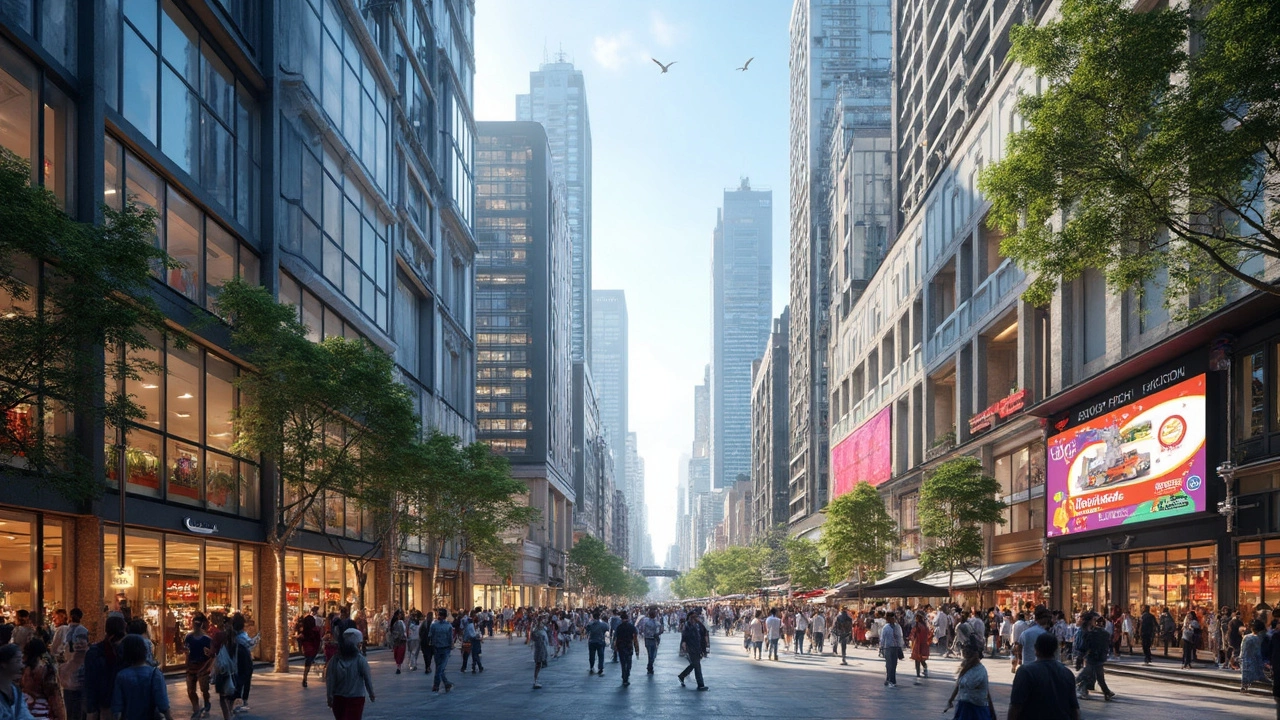Thinking about diving into commercial real estate? You're not alone—it's one of the most lucrative fields in property investment. But not all types of commercial property are created equal when it comes to making money.
Some sectors of commercial real estate naturally yield higher profits than others. For instance, office spaces in prime city locations can generate significant rental income. Similarly, retail space can be incredibly profitable, particularly in bustling areas where foot traffic is high.
Then there are mixed-use developments, which combine residential, commercial, and sometimes even industrial spaces. These can offer diversified income streams and tend to be stable investments.
But it's not just about the type of property; where it’s located can make a world of difference. Understanding market trends and the demand in specific locations can be the deciding factor between an average return and a phenomenal one.
- High-Profit Real Estate Segments
- The Role of Location
- Market Trends to Watch
- Tips for Boosting Returns
High-Profit Real Estate Segments
Not all parts of commercial real estate are equally lucrative. Some segments stand out because they offer better returns on investment, either through steady rental income or appreciation over time.
Office Spaces: The Corporate Hotspot
Office spaces, especially in key business districts, consistently rank high on the profitability scale. Companies are always in need of places to house their operations, and many are willing to pay a premium for the right location. The demand for office space usually remains stable, even during economic downturns.
Retail Properties: Where Foot Traffic Reigns
Retail properties, such as shopping centers and standalone stores, tend to offer high returns, mainly if they're positioned in high-traffic areas. Retail thrives on location and visibility. The right property in a vibrant commercial area can generate significant income. A good mix of anchor stores and smaller shops often adds to the appeal.
Industrial and Logistics: Riding the E-commerce Wave
With the rise of e-commerce, warehouses and logistics centers have become increasingly profitable. The need for storage and distribution hubs is growing, and investors are taking note. These properties typically require less maintenance than office or retail spaces and have lower overhead costs, which boosts net returns.
Mixed-Use Developments: The Best of Many Worlds
Mixed-use developments integrate residential, commercial, and sometimes industrial spaces. These properties attract a diverse set of tenants, which helps stabilize income streams. Plus, they make the most out of every square foot by accommodating different uses at the same time. This segment allows investors to hedge against downturns in any single market.
| Segment | Typical ROI | Key Pros |
|---|---|---|
| Office Spaces | 7-9% | Stable demand, consistent leases |
| Retail Properties | 6-8% | High visibility, diverse tenant mix |
| Industrial & Logistics | 8-10% | Demand driven by e-commerce |
| Mixed-Use Developments | 5-7% | Diverse income sources, flexible use |
Each of these real estate profit segments offers unique benefits and could be the ticket to achieving high returns, depending on the market conditions and the investor's strategy. Understanding the dynamics of each segment can provide great insights into maximizing potential gains.
The Role of Location
When it comes to commercial real estate, the old adage 'location, location, location' is more relevant than ever. The location of a property can dramatically affect its value and the kind of return you can expect. But what exactly about location makes such a difference?
Proximity to Demand
First off, properties located in thriving urban centers with high traffic get more attention and can command higher rents. Think of office spaces in downtown areas or retail spaces in popular shopping districts. These locations offer businesses easy access to customers, which is essential for their success.
Accessibility and Infrastructure
Another key factor is accessibility. Properties near major roads, public transport, or business hubs are more attractive because they’re easier to reach. Good infrastructure, like reliable internet and utilities, also plays a critical role in attracting tenants and buyers, making these locations much more profitable.
Future Growth Potential
It’s not just about where things are now but where they’re going. Areas slated for development or those with plans for major infrastructure upgrades often see a significant rise in real estate values. Savvy investors often keep an eye on city plans that include new transit lines or commercial developments to predict which areas will be in high demand in the near future.
Did you know new transit developments can increase property values by up to 20%? That's a huge gain just from being in the right spot at the right time.
Local Market Conditions
Considering the local market conditions is also crucial. High demand in a low-supply market typically drives up property prices and rents, offering better returns. On the flip side, oversaturated markets or declining areas might pose risks.
Conclusion
So, when you're looking at real estate investments, don't just look at the property itself. Ask yourself about its location, what's happening in the vicinity, and what future developments are planned. By understanding the role of location, you can make more informed, and ultimately more profitable, investment decisions.

Market Trends to Watch
Commercial real estate is ever-changing, and staying ahead of trends is crucial for making the most profit. But what exactly should you be keeping an eye on?
Remote Work and Office Space
The rise of remote work has transformed the demand for office spaces. Many companies are downsizing or opting for flexible workspaces. If you own or plan to invest in office real estate, consider layouts that accommodate hybrid working models. This means you might want to rethink those big, open office plans and instead create smaller, versatile spaces.
Retail Evolution
Retail, as we know it, is changing fast. Due to a spike in online shopping, brick-and-mortar stores need to offer something that e-commerce can't—experiences. Retail space investments that focus on experiential shopping or serve as showrooms for online brands tend to be successful.
Industrial Growth
Thanks to the constant rise in e-commerce, there's a booming demand for storage and distribution spaces. Investing in warehouses, especially those close to major transport hubs, could be a smart move. It's a sector that's set to keep growing as people continue to shop online.
Green Real Estate
Sustainability isn't just a buzzword; it's a significant factor in real estate decisions now. Properties boasting eco-friendly features or energy-efficient systems are more attractive to both businesses and investors. They often have lower running costs and tax incentives, making them a win-win.
| Year | Sector | Growth Percentage |
|---|---|---|
| 2023 | Flexible Office Space | 20% |
| 2024 | Industrial Warehousing | 15% |
Keep these trends in mind when considering your next move in the commercial real estate market. Adapting to these changes can be key to finding those high-profit opportunities.
Tips for Boosting Returns
So you've heard commercial real estate is where the big bucks are, but how do you really squeeze the most value out of your investments? Here are some tricks of the trade to consider.
Do Your Homework on Market Trends
Keeping an eye on market trends is crucial. The real estate profit you make often depends on anticipating shifts before they happen. Look into upcoming developments in the area, changes in business districts, and local economic forecasts that might impact property value.
Location is Key
Always remember, the location of your property investment can make or break your profit margins. Properties near public transport and amenities tend to attract more tenants and buyers. Explore demographics and upcoming infrastructure projects to forecast which areas could be the next hotspot.
Enhance Property Appeal
Sometimes, a few upgrades can go a long way in increasing your property’s value. Focus on modernizing the facilities, maintaining the exteriors, or even adding eco-friendly features. These improvements can not only increase the resale value but also bring in higher rental income.
Diversify Your Property Portfolio
Don’t put all your eggs in one basket. Diversifying your portfolio across different types of commercial properties—like retail, office, and mixed-use spaces—can provide steady cash flow and reduce risks associated with market volatility.
Consider Professional Property Management
If managing properties isn't your strong suit or is too time-consuming, hiring a professional can be a wise choice. They bring expertise in tenant management, reducing vacancies, and handling maintenance, which can substantially improve your real estate profit.
Use Leverage Wisely
Leverage can be your best friend or your worst enemy. Borrow wisely, and you can amplify your returns significantly. Just be sure you’re aware of the risks involved, and that any credit agreements are sound.
By focusing on these areas, you can optimize your commercial real estates investments and see those high returns you're aiming for.
